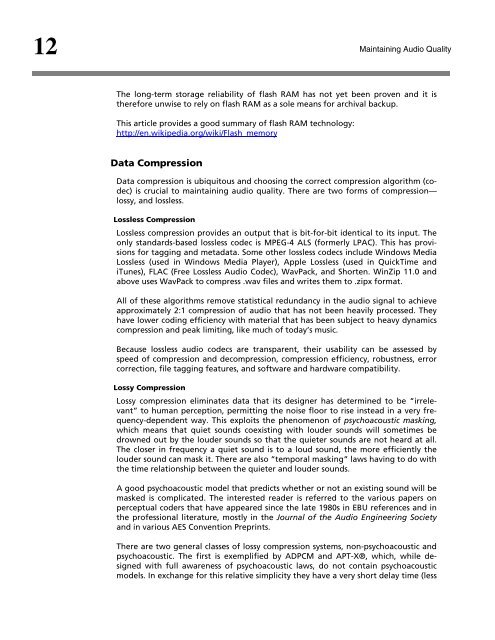Maintaining Audio Quality in the Broadcast Facility 2011 - Orban
Maintaining Audio Quality in the Broadcast Facility 2011 - Orban
Maintaining Audio Quality in the Broadcast Facility 2011 - Orban
You also want an ePaper? Increase the reach of your titles
YUMPU automatically turns print PDFs into web optimized ePapers that Google loves.
12<br />
<strong>Ma<strong>in</strong>ta<strong>in</strong><strong>in</strong>g</strong> <strong>Audio</strong> <strong>Quality</strong><br />
The long-term storage reliability of flash RAM has not yet been proven and it is<br />
<strong>the</strong>refore unwise to rely on flash RAM as a sole means for archival backup.<br />
This article provides a good summary of flash RAM technology:<br />
http://en.wikipedia.org/wiki/Flash_memory<br />
Data Compression<br />
Data compression is ubiquitous and choos<strong>in</strong>g <strong>the</strong> correct compression algorithm (codec)<br />
is crucial to ma<strong>in</strong>ta<strong>in</strong><strong>in</strong>g audio quality. There are two forms of compression—<br />
lossy, and lossless.<br />
Lossless Compression<br />
Lossless compression provides an output that is bit-for-bit identical to its <strong>in</strong>put. The<br />
only standards-based lossless codec is MPEG-4 ALS (formerly LPAC). This has provisions<br />
for tagg<strong>in</strong>g and metadata. Some o<strong>the</strong>r lossless codecs <strong>in</strong>clude W<strong>in</strong>dows Media<br />
Lossless (used <strong>in</strong> W<strong>in</strong>dows Media Player), Apple Lossless (used <strong>in</strong> QuickTime and<br />
iTunes), FLAC (Free Lossless <strong>Audio</strong> Codec), WavPack, and Shorten. W<strong>in</strong>Zip 11.0 and<br />
above uses WavPack to compress .wav files and writes <strong>the</strong>m to .zipx format.<br />
All of <strong>the</strong>se algorithms remove statistical redundancy <strong>in</strong> <strong>the</strong> audio signal to achieve<br />
approximately 2:1 compression of audio that has not been heavily processed. They<br />
have lower cod<strong>in</strong>g efficiency with material that has been subject to heavy dynamics<br />
compression and peak limit<strong>in</strong>g, like much of today’s music.<br />
Because lossless audio codecs are transparent, <strong>the</strong>ir usability can be assessed by<br />
speed of compression and decompression, compression efficiency, robustness, error<br />
correction, file tagg<strong>in</strong>g features, and software and hardware compatibility.<br />
Lossy Compression<br />
Lossy compression elim<strong>in</strong>ates data that its designer has determ<strong>in</strong>ed to be “irrelevant”<br />
to human perception, permitt<strong>in</strong>g <strong>the</strong> noise floor to rise <strong>in</strong>stead <strong>in</strong> a very frequency-dependent<br />
way. This exploits <strong>the</strong> phenomenon of psychoacoustic mask<strong>in</strong>g,<br />
which means that quiet sounds coexist<strong>in</strong>g with louder sounds will sometimes be<br />
drowned out by <strong>the</strong> louder sounds so that <strong>the</strong> quieter sounds are not heard at all.<br />
The closer <strong>in</strong> frequency a quiet sound is to a loud sound, <strong>the</strong> more efficiently <strong>the</strong><br />
louder sound can mask it. There are also “temporal mask<strong>in</strong>g” laws hav<strong>in</strong>g to do with<br />
<strong>the</strong> time relationship between <strong>the</strong> quieter and louder sounds.<br />
A good psychoacoustic model that predicts whe<strong>the</strong>r or not an exist<strong>in</strong>g sound will be<br />
masked is complicated. The <strong>in</strong>terested reader is referred to <strong>the</strong> various papers on<br />
perceptual coders that have appeared s<strong>in</strong>ce <strong>the</strong> late 1980s <strong>in</strong> EBU references and <strong>in</strong><br />
<strong>the</strong> professional literature, mostly <strong>in</strong> <strong>the</strong> Journal of <strong>the</strong> <strong>Audio</strong> Eng<strong>in</strong>eer<strong>in</strong>g Society<br />
and <strong>in</strong> various AES Convention Prepr<strong>in</strong>ts.<br />
There are two general classes of lossy compression systems, non-psychoacoustic and<br />
psychoacoustic. The first is exemplified by ADPCM and APT-X®, which, while designed<br />
with full awareness of psychoacoustic laws, do not conta<strong>in</strong> psychoacoustic<br />
models. In exchange for this relative simplicity <strong>the</strong>y have a very short delay time (less



![[PDF] Using the ITU BS.1770-2 and CBS Loudness Meters ... - Orban](https://img.yumpu.com/50629372/1/190x245/pdf-using-the-itu-bs1770-2-and-cbs-loudness-meters-orban.jpg?quality=85)






![[PDF] Optimod-FM Feature Comparison - Orban](https://img.yumpu.com/41741615/1/190x245/pdf-optimod-fm-feature-comparison-orban.jpg?quality=85)






